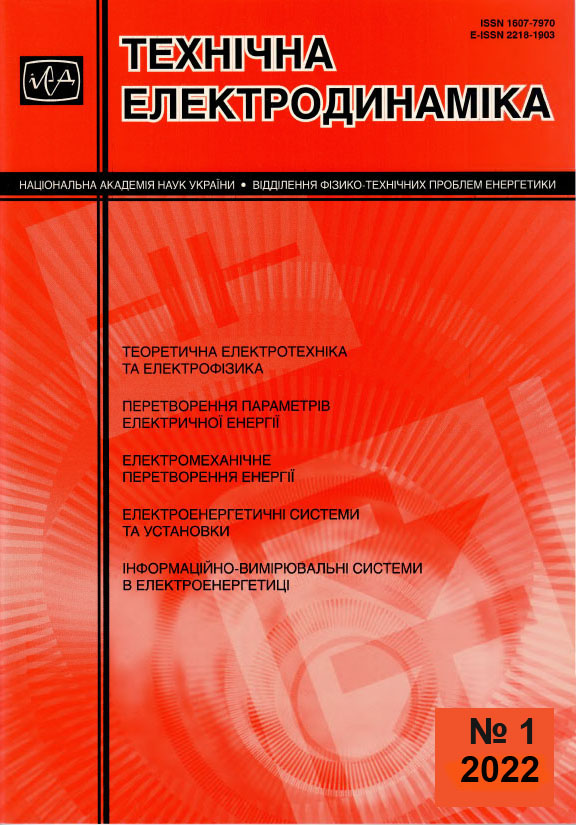Анотація
У роботі визначено конструктивні параметри лінійного двигуна вібраційної дії відповідно до заданих критеріїв оптимізації (мінімальна вартість, максимальні питомі силові показники та ККД) і режиму механічного навантаження. Для цього розроблено комп’ютерну модель, в основу якої покладено магнітну та електричну схеми заміщення із зосередженими параметрам. Магнітне коло моделі побудовано з урахуванням насичення матеріалу магнітопроводу, магнітних втрат та потоків розсіювання. Амплітуда електромагнітної сили двигуна визначається на підставі першої гармоніки магнітної індукції в повітряному проміжку. Механічну частину моделі побудовано з використанням методу електромеханічних аналогій, згідно з яким індуковану внаслідок руху якоря ЕРС представлено падінням напруги на еквівалентному механічному опорі. Завдання вибору конструктивних параметрів для заданих характеристик механічного навантаження розглядається сукупно з урахуванням нелінійних зв’язків системи і за умови теплових, магнітних та електричних обмежень. За допомогою методу градієнтного спуску проведено оптимізацію параметрів двигуна та визначено найбільш ефективні конструктивні виконання, які задовольняють обраним критеріям. Бібл. 8, рис. 5, табл. 2.
Посилання
Bondar R.P., Podoltsev A.D. Complex model with frequency dependent parameters for electrodynamic shaker characteristics. Tekhnichna Elektrodynamika. 2017. No 1. Pp. 44-51. DOI: https://doi.org/10.15407/techned2017.01.044. (Ukr).
Wang J., Howe D., Jewell G.W. Analysis and design optimization of an improved axially magnetized tubu-lar permanent-magnet machine. IEEE Transactions on Energy Conversion. 2004. Vol. 19. No 2. Pp. 289-295. DOI: https://doi.org/10.1109/TEC.2004.827026.
Bondar R.P. Operating characteristics of the linear permanent magnet vibratory motor with viscoelastic loading. Electromechanical and energy saving systems. Kremenchuk, 2019. Vol. 3. No 47. Pp. 48-56. DOI: https://doi.org/10.30929/2072-2052.2019.3.47.48-56. (Ukr).
Denysov Yu.O., Bursala O.O. Influence of the supply voltage ripple of the linear electric motor on the pa-rameters of the transient response of the current loop of the on-board aviation positioning system. Tekhnichna Elektro-dynamika. 2021. No 6. Pp. 20-28. DOI: https://doi.org/10.15407/techned2021.06.020. (Ukr).
Mizuno T., Yanagawa T., Takai M., Utsuno M., Yamamoto H., Shibuya K., Yamada H. A novel efficiency measurement of moving-magnet-type linear oscillatory actuator. International Journal of Applied Electromagnetics and Mechanics. 2001. No 15. Pp. 163-167. DOI: https://doi.org/10.3233/JAE-2002-438.
Cherno O.O., Monchenko M.Yu. Energy efficiency of the vibratory device electromagnetic drive system. Tekhnichna Elektrodynamika. 2016. No 1. Pp. 20-25. DOI: https://doi.org/10.15407/techned2016.01.020.
Gieras J.F., Piech Z.J., Tomczuk B. Linear Synchronous Motors. Transportation and Automation Systems, Second Edition. CRC Press, 2012. 520 p.
Akhondi H., Milimonfared J. Design and optimization of tubular permanent magnet linear motor for electric power steering system. Journal of Asian Electric Vehicles. 2009. No 7. Pp. 1283-1289. DOI: https://doi.org/10.4130/jaev.7.1283.

Ця робота ліцензується відповідно до Creative Commons Attribution-NonCommercial-NoDerivatives 4.0 International License.
Авторське право (c) 2022 Array






